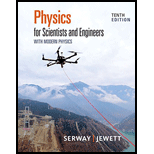
The classification of waves of frequencies
Answer to Problem 34AP
The classification of waves on the basis of frequency is shown below.
| Frequency,
|
Wavelength, | Classification | ||
|
|
| Radio | ||
|
|
|
Radio | ||
|
|
|
Radio | ||
|
|
|
Microwave | ||
|
|
|
Infrared | ||
|
|
|
Ultraviolet | ||
|
|
|
X-ray | ||
|
|
|
Gamma ray | ||
|
|
|
Gamma ray | ||
The classification of waves on the basis of wavelength is shown below.
| Wavelength, |
Frequency,
| Classification | ||
|
|
| Radio | ||
|
|
|
Radio | ||
|
|
|
Microwave | ||
|
|
|
Infrared | ||
|
|
|
Ultraviolet/ X-ray | ||
|
|
|
X-ray/Gamma ray | ||
|
|
|
Gamma ray | ||
|
|
|
Gamma ray | ||
Explanation of Solution
The formula to calculate the wavelength is,
Here,
Substitute
Substitute
Substitute
Substitute
Substitute
Substitute
Substitute
Substitute
Substitute
From the above calculation, the table for the wavelength can be deduces and the respective classification of waves is shown.
| Frequency,
|
Wavelength, | Classification | ||
|
|
| Radio | ||
|
|
|
Radio | ||
|
|
|
Radio | ||
|
|
|
Microwave | ||
|
|
|
Infrared | ||
|
|
|
Ultraviolet | ||
|
|
|
X-ray | ||
|
|
|
Gamma ray | ||
|
|
|
Gamma ray | ||
The formula to calculate the frequency is,
Here,
Substitute
Substitute
Substitute
Substitute
Substitute
Substitute
Substitute
Substitute
From the above calculation the table for the frequency can be deduces and the respective classification of waves is shown below.
| Wavelength, |
Frequency,
| Classification | ||
|
|
| Radio | ||
|
|
|
Radio | ||
|
|
|
Microwave | ||
|
|
|
Infrared | ||
|
|
|
Ultraviolet/ X-ray | ||
|
|
|
X-ray/Gamma ray | ||
|
|
|
Gamma ray | ||
|
|
|
Gamma ray | ||
Conclusion:
Therefore, the table of classification of waves with the frequencies is shown below.
| Frequency,
|
Wavelength, | Classification | ||
|
|
| Radio | ||
|
|
|
Radio | ||
|
|
|
Radio | ||
|
|
|
Microwave | ||
|
|
|
Infrared | ||
|
|
|
Ultraviolet | ||
|
|
|
X-ray | ||
|
|
|
Gamma ray | ||
|
|
|
Gamma ray | ||
Therefore, the table of classification of waves with the wavelengths is shown below.
| Wavelength, |
Frequency,
| Classification | ||
|
|
| Radio | ||
|
|
|
Radio | ||
|
|
|
Microwave | ||
|
|
|
Infrared | ||
|
|
|
Ultraviolet/ X-ray | ||
|
|
|
X-ray/Gamma ray | ||
|
|
|
Gamma ray | ||
|
|
|
Gamma ray | ||
Want to see more full solutions like this?
Chapter 33 Solutions
Physics for Scientists and Engineers with Modern Physics
- 20. Two small conducting spheres are placed on top of insulating pads. The 3.7 × 10-10 C sphere is fixed whie the 3.0 × 107 C sphere, initially at rest, is free to move. The mass of each sphere is 0.09 kg. If the spheres are initially 0.10 m apart, how fast will the sphere be moving when they are 1.5 m apart?arrow_forwardpls help on allarrow_forwardpls help on thesearrow_forward
- pls help on all asked questions kindlyarrow_forwardpls help on all asked questions kindlyarrow_forward19. Mount Everest, Earth's highest mountain above sea level, has a peak of 8849 m above sea level. Assume that sea level defines the height of Earth's surface. (re = 6.38 × 106 m, ME = 5.98 × 1024 kg, G = 6.67 × 10 -11 Nm²/kg²) a. Calculate the strength of Earth's gravitational field at a point at the peak of Mount Everest. b. What is the ratio of the strength of Earth's gravitational field at a point 644416m below the surface of the Earth to a point at the top of Mount Everest? C. A tourist watching the sunrise on top of Mount Everest observes a satellite orbiting Earth at an altitude 3580 km above his position. Determine the speed of the satellite.arrow_forward
- pls help on allarrow_forwardpls help on allarrow_forward6. As the distance between two charges decreases, the magnitude of the electric potential energy of the two-charge system: a) Always increases b) Always decreases c) Increases if the charges have the same sign, decreases if they have the opposite signs d) Increases if the charges have the opposite sign, decreases if they have the same sign 7. To analyze the motion of an elastic collision between two charged particles we use conservation of & a) Energy, Velocity b) Momentum, Force c) Mass, Momentum d) Energy, Momentum e) Kinetic Energy, Potential Energyarrow_forward
 An Introduction to Physical SciencePhysicsISBN:9781305079137Author:James Shipman, Jerry D. Wilson, Charles A. Higgins, Omar TorresPublisher:Cengage Learning
An Introduction to Physical SciencePhysicsISBN:9781305079137Author:James Shipman, Jerry D. Wilson, Charles A. Higgins, Omar TorresPublisher:Cengage Learning Glencoe Physics: Principles and Problems, Student...PhysicsISBN:9780078807213Author:Paul W. ZitzewitzPublisher:Glencoe/McGraw-Hill
Glencoe Physics: Principles and Problems, Student...PhysicsISBN:9780078807213Author:Paul W. ZitzewitzPublisher:Glencoe/McGraw-Hill Principles of Physics: A Calculus-Based TextPhysicsISBN:9781133104261Author:Raymond A. Serway, John W. JewettPublisher:Cengage Learning
Principles of Physics: A Calculus-Based TextPhysicsISBN:9781133104261Author:Raymond A. Serway, John W. JewettPublisher:Cengage Learning
 University Physics Volume 1PhysicsISBN:9781938168277Author:William Moebs, Samuel J. Ling, Jeff SannyPublisher:OpenStax - Rice University
University Physics Volume 1PhysicsISBN:9781938168277Author:William Moebs, Samuel J. Ling, Jeff SannyPublisher:OpenStax - Rice University AstronomyPhysicsISBN:9781938168284Author:Andrew Fraknoi; David Morrison; Sidney C. WolffPublisher:OpenStax
AstronomyPhysicsISBN:9781938168284Author:Andrew Fraknoi; David Morrison; Sidney C. WolffPublisher:OpenStax





